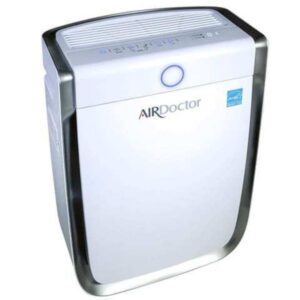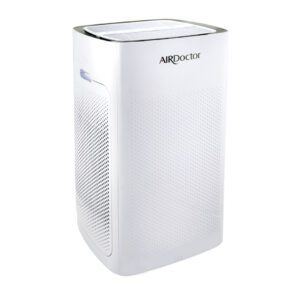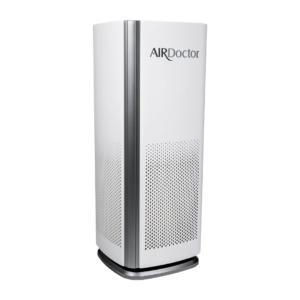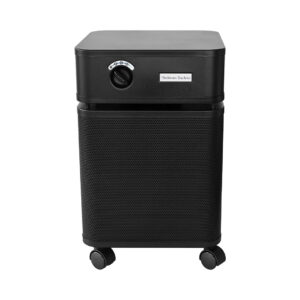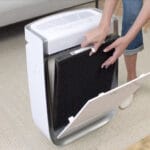Everyone deserves to breathe clean air… both outdoors AND indoors. The air within our homes can be extremely polluted. What airborne contaminants can be found indoors? Are ozone air purifiers safe? What’s the best air purifier on the market? What should you look for in an air purifier? Keep reading to learn more!
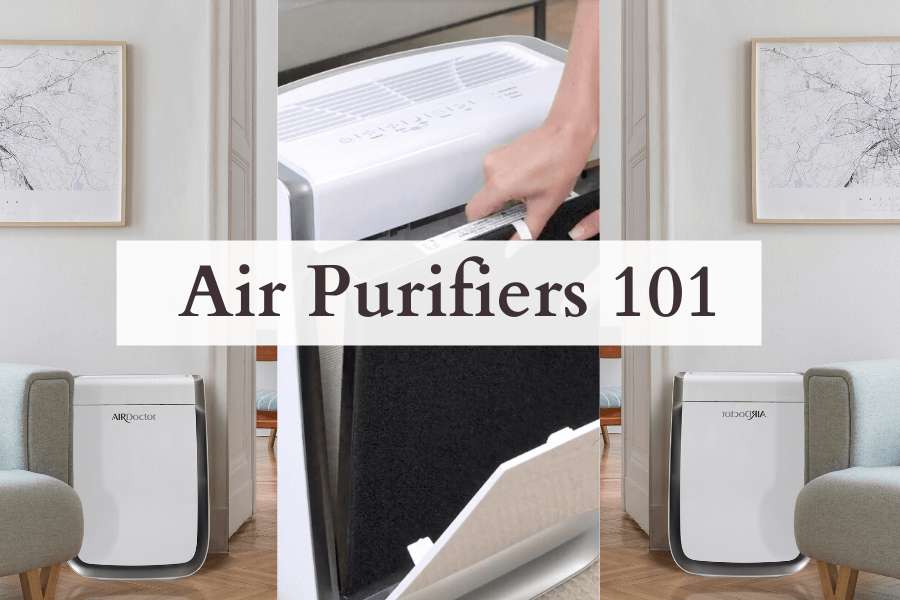
Photo from Ideal Living AirDoctor (Note: This article contains affiliate links, meaning In On Around will make a small commission at no additional cost to you. This helps me maintain the site. As always, I value full transparency & only work with brands I love and trust.)
Why Do You Need An Air Purifier?
The air we breathe at home is not always what it seems! There can be a host of pollutants found inside.
On average, indoor air quality is 2-5 times more polluted than outdoor air quality.
EPA
What Contaminants Can Be Found In Indoor Air?
- Volatile Organic Compounds (VOCs)
- Dust mites
- Pet dander
- Mold
- You can read more about mold here: Mold Detox Protocol – Recover From Mold Illness
- Cleaning Products
- You can read more about nontoxic cleaning products here: 11 Natural Cleaning Products & The Best Spring Cleaning Checklist
- Fragrance, like from candles and plug-ins
- You can read more about fragrance here: Safe Fragrance 101 – Hidden Toxins In Scents
- Tobacco smoke or other kinds of smoke
- Paint & paint supplies
- Flame retardants
- Bacteria
- Viruses
- Pesticides
- Dry-cleaned materials
- Flooring and carpeting
- Insect waste
- Building materials
- Pollen
- Carbon Monoxide or Radon (hopefully not!)
75% of U.S. households use at least one pesticide indoors every year.
80% of exposure to pesticides occurs indoors.
EPA
How Can Airborne Contaminants Impact Your Health?
Indoor contaminants can impact your health in more ways than one.
- Respiratory issues
- Eye irritation
- Nasal irritation
- Headaches
- Nausea
- Fatigue
- Confusion
- Asthma
- Cancer
- Skin rash
- Memory impairments
- Decreased fertility
… the list goes on.
The toxins you breathe in through your respiratory system can damage your lungs and can be circulated throughout the body with the heart, liver, brain, kidneys, and more. The more you’re exposed to harmful airborne contaminants, the worse off your health can be.
92% of the world is breathing in dangerous amounts of pollutants.
WHO
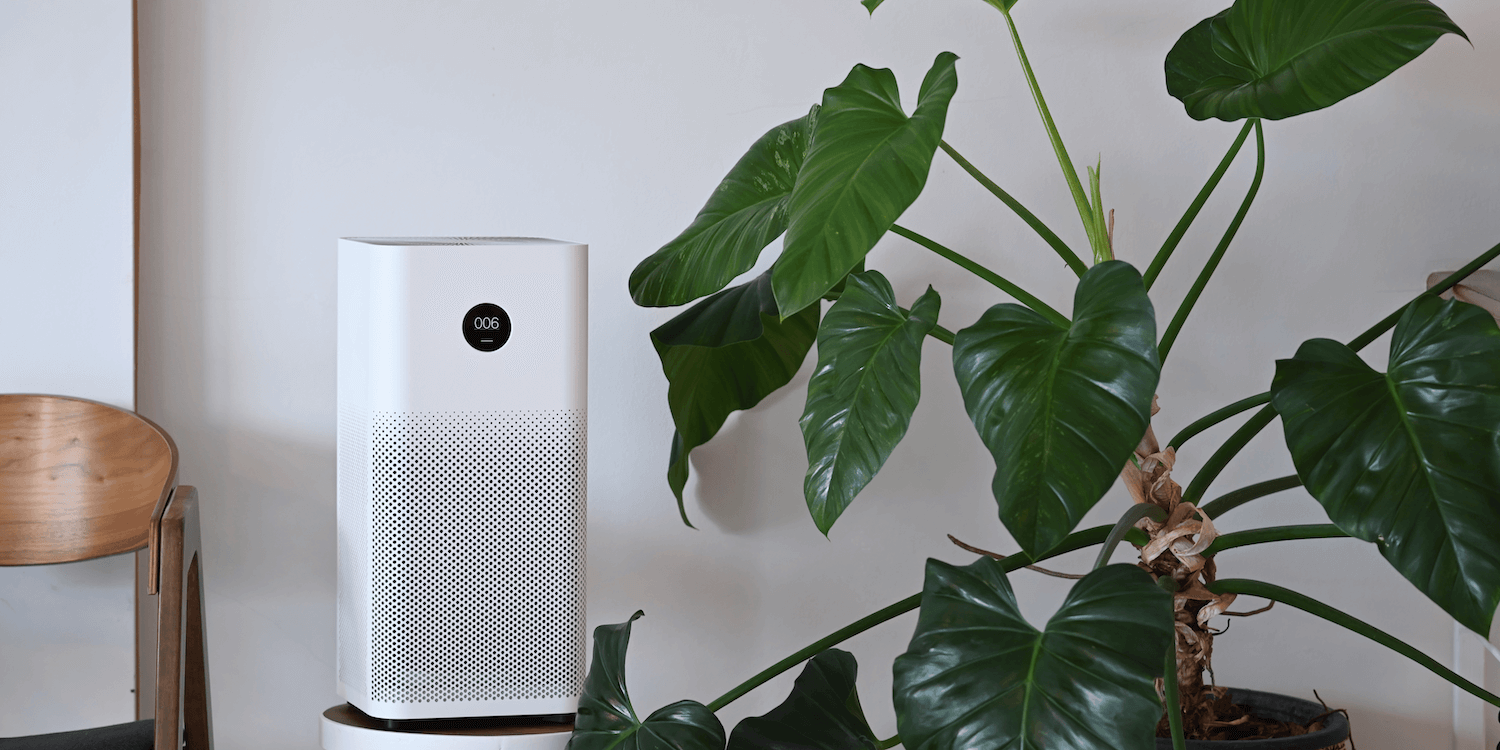
What’s The Difference Between An Air Filter And An Air Purifier?
Air filters and air purifiers are oftentimes confused… but they have very distinct differences!
An air filter is oftentimes attached to HVAC (heating, ventilation, and air conditioning) units to trap airborne particles. Its main purpose is to keep debris from entering the HVAC system.
An air purifier removes pollutants from the air so they don’t remain airborne. [1] Air purifiers are stand-alone appliances designed to purify the air.
There are five main types of air purifiers:
- HEPA
- Ultraviolet (UV)
- Activated Carbon
- Negative Ion
- Ozone
On average, people spend 90% of their time indoors.
EPA
What Is A MERV Rating?
MERV stands for Minimum Efficiency Reporting Values.
- MERV essentially is the filter’s ability to capture airborne particles between the size of 0.3 and 10 microns (µm). As the name states, it measures how efficient the filer actually is.
- The better the MERV rating, the better the filter (meaning fewer contaminants pass through)!
- MERV sizes 17-20 can filter particles less than 0.3 microns (µm) in size (which is very good!)
It’s best to find an air purifier that can filter below 0.1 microns (µm). To filter most viruses, purifiers should filter 0.007 microns (µm) or lower.
What Is HEPA And True Hepa?
HEPA stands for High-Efficiency Particulate Air… but True HEPA filters are the best of the best!
- HEPA filters remove 99.99% of pollutants 2+ microns (µm) in size
- True HEPA filters remove 99.97% of airborne particles as small as 0.3 microns (µm) – much smaller!
- HEPA only works for particulates in the air, not for gasses like volatile organic compounds (VOCs)
- In order to remove VOCs and harmful gasses from the air, the purifier must also have high efficiency gas absorption (HEGA) cloth or activated carbon filter.
- Don’t fall victim to “HEPA-like” and “HEPA-type” product marketing. These are confusing marketing terms for lower-quality products that are intended on confusing the consumer!
- Medical-grade HEPA filters can be a great high-quality option.
What Is Ozone?
Ozone (with the chemical composition of O3) is a reactive gas composed of three oxygen atoms. It occurs naturally in the Earth’s atmosphere, but can also be released from man-made products, such as certain ionic air filters/purifiers.
Are Ozone Generators Safe?
It depends on the use!
Ozone air purifiers can seriously damage your lungs. Inhaling even a small amount of ozone can lead to shortness of breath, chest pain, coughing, and other respiratory issues. You should never breathe in ozone from air purifiers. If your filter has an ozone option, make sure it is off! This includes ionizers, which can release ozone into the air. Never breathe in high concentrations of ozone or use ionizing air purifiers in an occupied room.
We breathe about 23,000 breaths every day.
Medium
Never use an ozone air purifier while you’re in the room (it also has a distinct smell, so you’ll likely know if the purifier is releasing ozone).
Ozone air purifiers are oftentimes used in deep cleaning to reduce strong odors (like between rental unit tenants or during a deep, deep clean). They can be extremely effective in removing odor, however only use an ozone air purifier when you’re NOT in the room. After the purifier runs, make sure you fully air out the room before using it again.
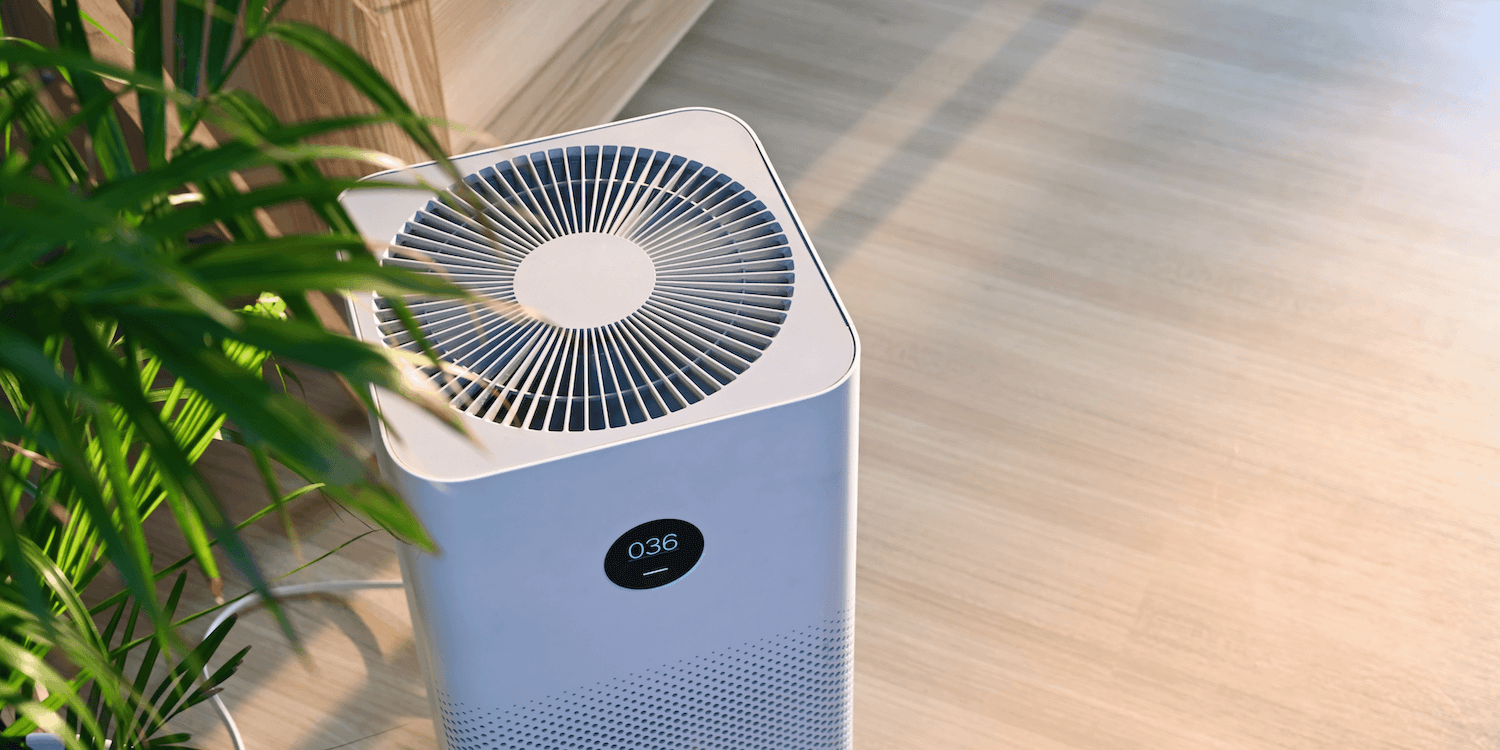
Are Air Purifiers The Same As Air Sanitizers?
Nope! Air Sanitizers are oftentimes aerosol disinfectant sprays, which should never, ever be inhaled. Unless absolutely necessary, it’s best to steer clear of any air sanitizing products – they’re unnecessary. Instead, use a high-quality air purifier.
Do You Need An Air Filter And An Air Purifier?
Yes, it’s best to have both an air filter (for your home HVAC system) and air purifiers throughout the house. This will help to ensure the highest-quality air throughout your home.
Are Air Purifiers Worth It?
Yes, air purifiers are worth the cost! They are one of the best ways to clean up indoor air quality. It is usually safe to run an air purifier 24/7 but use caution, as with all electric devices.
What’s The Best Way To Clean Air In A Car?
A Purrgo Air Freshener can be a good option for purifying the air in your car. It uses 100% activated bamboo charcoal and it’s free of nasty fragrances, plastic or harmful chemicals. Plus, it doesn’t require any electricity, so it’s easy to use in any car.
Of course, the best way to clean the air in your car is to simply open your windows! As long as the outdoor air quality is good, opening your windows will provide more ventilation. As mentioned before, you can view the outdoor air quality ranking here.
Keep in mind that car air fresheners are not “air purifiers” by any means. They can help to absorb odors and filter the air, but they are not nearly as powerful as an electronic air purification appliance.
Additionally, it’s time to ditch the toxic air fresheners – these do NOT clean the air, rather they pollute it. It’s important to eliminate pollutants instead of masking odors with toxic synthetic fragrances.
Best Air Purifier Buying Guide
What to use instead of an ozone air purifier:
AirDoctor is my favorite, but Austin Air is another amazing option! Keep in mind that any air purifier is better than no air purifier (as long as it’s not releasing an odor or ozone). You deserve to know which products are the best.
#1 – AirDoctor
(Less Expensive Initially, Great Quality, Best For Ultrafine Airborne Particles)
The AirDoctor is available in three different models:
- AirDoctor 1000 – circulates air 2x/hour in 570 square feet
- AirDoctor 3000 – circulates air 2x/hour in 1,274 square feet
- AirDoctor 5000 – circulates air 2x/hour in 2,001 square feet
The AirDoctor systems are the more affordable, high-quality air purifiers on the market and can filter particles as small as 0.003 microns (µm). It filters odors, gases, ozone, volatile organic compounds (VOCs), and more!
Why AirDoctor is one of the highest-quality air purifiers available:
- Its filtration standard is 100x smaller than the HEPA standard.
- It can remove up to 99.99% of tested bacteria and viruses from the air (like H1N1)
- Yes – it can even remove 99.97% of SARS-CoV-2 virus! [2]
- The sensor adjusts to let you know the air quality! (Blue = good, Orange = moderate, Red = poor)
- The fans are quiet and perfect in bedrooms! They’re 30% quieter than fans in other air purifiers.
- It will let you know exactly when the filter needs to be replaced (no guesswork!)
- The pre-filter traps larger particles like pet hair (and can be vacuumed cleaned).
Keep in mind that AirDoctor activated carbon filters (which filter out VOCs) must be replaced every 6 months to remain effective. The UltraHEPA filter must be replaced every year to remain effective.
Although AirDoctor has less activated carbon (about 0.6-3 lbs) than some other units (like Austin Air), I prefer it because of the affordable price, quality filters, fan noise, and sensor.
#2 – Austin Air
(More Expensive Initially, Best Quality, Best For VOCs/Gasses)
Austin Air also has great reviews and can remove 99.97% of all particles 0.3+ microns and 95% of all particles 0.1+ microns. These filters have 15 lbs of activated carbon, which is fantastic for removing volatile organic compounds from the air.
They also don’t release any ozone and filters only need to be replaced every 5 years. This has a higher initial cost than AirDoctor, but it doesn’t require as much maintenance. It does not, however, have a filter replacement sensor.
How Often Should You Replace The Filters In Your Air Purifier Or Air Filter?
It’s incredibly important to regularly maintain your filter to ensure it’s working properly. The higher the MERV rating on the system, the more frequently you will need to change out the filter.
How often you change out the filter depends on the type of filter you’re using.
For AirDoctor 1000, for instance, the set of filters should be replaced every 6 months. For best results, read the maintenance manual provided by your air purification unit.
Air Purifier Best Practice Tips
- Make sure you place your air purifier in high-traffic areas (like bedrooms and kitchens).
- Skip using low-quality air purifiers (like the majority of the purifiers sold in big-box stores and online). If you’re going to invest in a system that actually works, I recommend checking out AirDoctor. Let’s use your hard-earned money on purifiers that work!
- Don’t just rely on consumer rankings to select an air purifier. Instead, focus on the quality of the filter & the science behind it.
- Avoid using ozone generating devices unless in an uninhabited room.
- Although air purifiers can significantly improve the air quality in your home, it’s not the end-all-be-all. Proper home maintenance and cleaning is still the best way to avoid breathing in airborne pollutants.
- Keep in mind that air purifiers cannot remove all pollutants from the air.
How Can You Improve Indoor Air Quality Without An Air Purifier?
- Ventilation is key!
- If the outdoor air quality is good, open up your windows! You can check outdoor air quality here.
- Avoid using toxic cleaning products and pesticides indoors (opt for more natural bug & pest control)
- Avoid smoking in the house (… and smoking in general! It’s time to QUIT.)
- Avoid burning synthetic fragranced candles
- Opt for low-VOC paint (these don’t off-gas as much, although it’s still important to avoid breathing it in)
- Regularly hire a high-quality HVAC cleaning company to remove
- Whole-house air purification systems usually only filter particulates, not gases or odors.
- Learn how to properly dust!
- Instead of feathering dust away, use a microfiber towel to grab onto the dust. It’s important to avoid making the dust airborne.
- Opt for nontoxic furniture, such as a nontoxic mattress, which will not off-gas volatile organic compounds in to the air (VOCs)
- You can read more about nontoxic mattresses here: The Most Affordable Nontoxic, Organic & Safe Mattress
- When doing home renovations, like painting always keep your windows open for adequate airflow.
- If you use a fire place, make sure it’s regularly cleaned to ensure smoke does not enter your home.
- Vacuum your house regularly (… like daily, if you can!)
- If you work in an office, consider getting an air purifier for your office space (especially if you spend a ton of time at work!).
- If you have mold in your house, work with a qualified mold remediator to properly remove those toxins from your environment.
- Watch my Instagram Live with a mold remediator here!
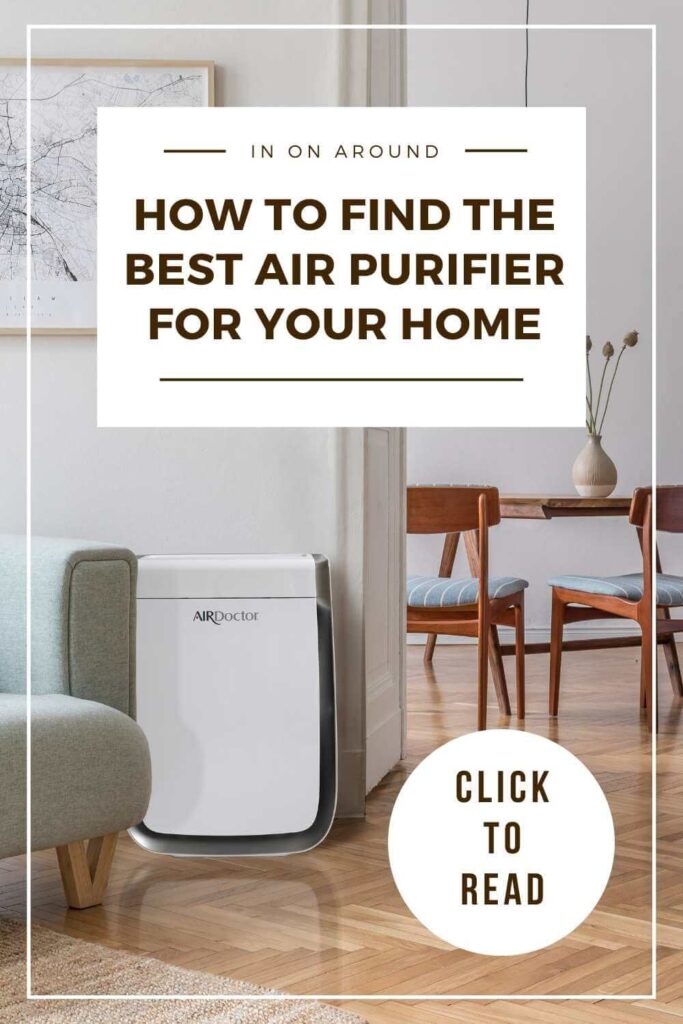
Frequently Asked Questions: Best Air Purifiers
What Contaminants Can Be Found In Indoor Air?
What Is A MERV Rating?
Are Air Purifiers The Same As Air Sanitizers?
How Often Should You Replace The Filters In Your Air Purifier Or Air Filter?
Do you use an air purifier?
Let me know your thoughts in the comments down below.
Please rate & review this article – I appreciate the support!
You can watch our web story here.
xoxo,

Want to read more? Check out my other articles here!
Information on Mold Detox Protocol from: EPA, CDC, Allergy And Air, Newswire, AirDoctor, Mamavation, Aireserv, Sana Life, Rolling Stone, Medify Air, Austin Air, I Read Labels For You
Copyright In On Around LLC 2022 ©. The statements made on this website have not been evaluated by the FDA (U.S. Food & Drug Administration). They are not intended to diagnose, treat, cure, or prevent any disease. The information provided by this website should not be used as individual medical advice and you should always consult your doctor for individual recommendations and treatment.

